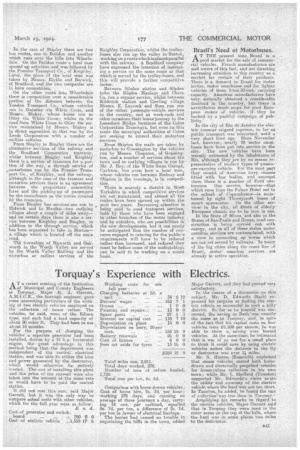Torquay' s Experience with Electrics.
Page 25

If you've noticed an error in this article please click here to report it so we can fix it.
AT a recent meeting of the Institution of Municipal and County Engineers at Torquay, • Major H. A. Garrett-, A.M.I.C.E.,the borough engineer, gave some interesting particulars of the working of two electric vehicles employed on the collection of • house refuse. The vehicles, he said, were of the Edison type, and each had a load capacity of about-PG cubic ft. They had been in use about 18 months.
For the purpose of charging the vehicles a separate generator had been installed, driven by a 12 h.p. horizontal engine, the a advantage in this method being that the department was independent of the central electrical station, and was able to utilize the heat and power generated by thedestructor, which would otherwise he. entirely wasted. The cost of installing this plant and the price of the cnrrent were also taken into the account at the same rate as would have to be paid the central station.
It did not cost this sum, said Major Garrett, but it was the only way to compare actual coals with other vehicles, which for the full. year were as follow : s. d. Cost of generator and switch board 280 0 0 Cost of eleetric vehicle _1,559 17 6 Comparison with horse-drawn vehicles : Cost of horse hire, 2s. 3d. per hour; working 276 days, and running an average of three journeys a day, carrying 14 cwt. per cartload, equalled 8s. 7d. per ton, a difference of 2s. lad. per ton in favour of electrical haulage.
The lorries had caused no trouble in negotiating the hills in the town, added Maier Garrett, and they had proved very satisfactory_
In the course of a discussion an this subject, Mr. D. Edwards (Bath) expressed his surprise at finding the electric vehicle so successful in such a hilly district. So far as he himself was concerned, the savingin Bath; was exactly the same as in Torquay, and, in spite of the fact that his-capital costs on four vehicles were £1.200 per annum, he was able to show a, saving over horsed vehicles. At the samatirne, he intimated that-it was of no use for a small place to think it could save by using electric vehicles unless the distance to the tip or destructor was over 14 miles.
Mr. S. Hutton (Exmouth) explained that steam vehicles ousted both horsedrawn and electrically propelled vehicles for house-refuse collection in his own town; while Mr. I. Shellard (Taunton) supported Mr. Edwards's views as to the utilityand economy of the electric vehicle where the haul was not too short. In Taunton, be added, he found the cast of collection' was less than in Torquay.
Amplifying his remarks in regard to the electric vehicles, Major Garrett said that in Torquay they were used in the outer areas on ale top of the hills, where the haul was in some places two miles to the deatructor.






























